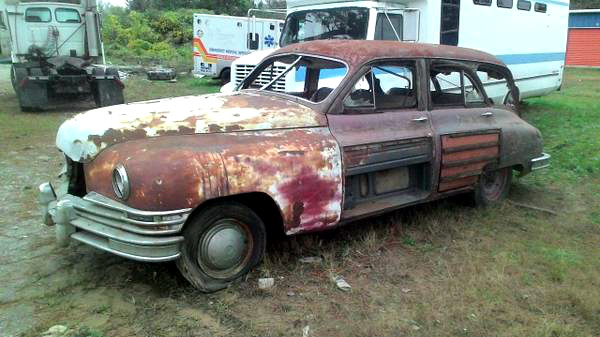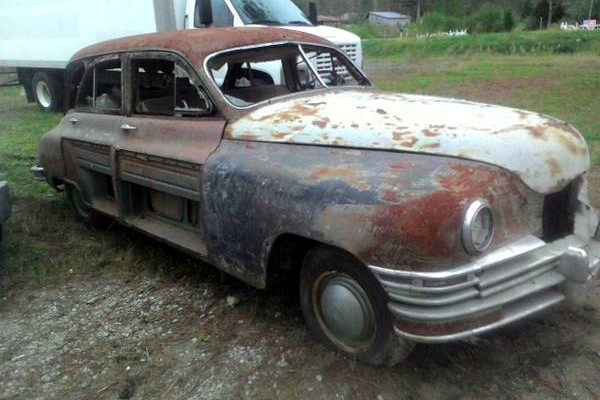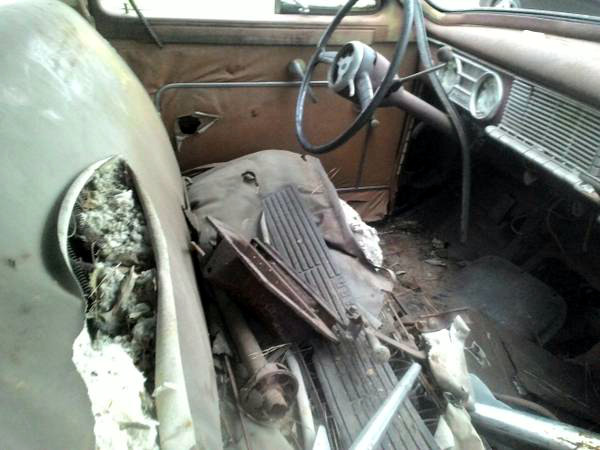Filed under the “rare as hen’s teeth” department, would be this 1949 Packard “Woody” station wagon. It appears here on craigslist in Huntsville, Alabama. Reportedly, just 3,864 total of these were manufactured over three years of production, 1949 being the first year. Woody wagons in general are rare enough, this Packard variant even more so.
While this one is not for the timid hobby restorer, it’s worth looking at due to it’s rarity and desirability. This 1949 Packard “woody” station wagon needs a complete frame-off restoration, but the amount of curb appeal the finished product would have is considerable. Alabama being south of the rust belt, this car might be something decent to start with. These Packard woodies appear to have been made of mostly metal, so if this one isn’t too rusty, it’s very do-able. The seller’s description of this important factor is nil, but the photos of it look pretty good, and it appears to have lower edges on the door and fender bottoms. The prices on many woody wagons having long ago surpassed the forty thousand dollars and up threshold, this one is certainly worth considering for the big project that it is. Despite the great vintage, four door parts cars are still relatively inexpensive and easy to find, so the missing drivetrain is not as big of a problem as it might seem.
“Ask the man who owns one” was the slogan used by Packard for many years, the obvious concept being that brand loyalty and word of mouth could do as much to sell their cars as any other kind of advertising could. This is worth noting, as prior to 1950, Packard actually outsold Cadillac! Where the folks at Packard lost their way after that, may have been due in part to the inability to keep up with the big dollars GM poured in to Cadillac’s new overhead valve V8, and automatic transmission. Another reason may have been the styling. While some referred to this as a “pregnant elephant” or an “upside down bath tub”, others loved it, and they sold well. While no one can argue how much of a departure the 1951 models were from this one, it was an attempt to keep up with the rapidly-changing tastes and styles of the time, and a mad scramble to get back up to speed after the heroic war time production done by Packard. Later in the 1950s, the ill-advised merger with the also-ailing Studebaker Corporation is what finally ended up killing the marque. The Packard was an important manufacturer in the first half of the twentieth century and their rich history, if you’re not familiar with it, is worth reading about in far greater detail than I have space for here.
The Packard being as popular as it was in its day, left behind a proud legacy of great cars made both before and after the war, and this provides us even a half century later with plenty of their cars to drive, use and appreciate. Including this very rare and very desirable “woody” station wagon.
The opportunity to find oneself upside down in a restoration is possible with nearly any classic car. This one needs a no-expense spared total restoration. Many of us would feel obligated to do this particular car by the numbers; find the correct drivetrain, paint it the proper colors, and so on. This is the “safe” way to invest in this car, right? Not necessarily. A tastefully done street rod built with excellent craftsmanship can easily be worth as much, and many cases, more than a proper “correct” restoration. So those of us here at Barn Finds have got to know: Original, or not? How would you do it? And what do you think of the asking price for this car, the value of which would easily exceed 40K when finished?







The fragility of wood leads one to consider alternatives unless one wants to dump a lot of money into a project that will cost more than any possible resale.
The seller says it comes with a complete factory wood kit and it really doesn’t look rusty at all. It’s a hell of a project but it could totally be done by a hobbyist with enough dough and time to spare. I’d find an engine/trans and just rat rod it.
Yah, “just rat rod it”. It isn’t good for anything anyway! Why waste time doing it right? Just turn it into another hodge-podge of psychedelic ‘art’ and run it through Barrett-Jackson, right?
Please don’t offer to restore any cars for me.
What a grump! Not every old car that isn’t original is “wrong”. Sometimes they can just be things – fun things, safer things, interesting things.
Since the amount of money to restore this to perfection would outweigh its resale value… I guess you’d rather see it rot.
Sorry, but a “tasteful street rod” is like an honest gas station: it doesn’t exist, but most especially when applied to a rare car like this Packard Station Sedan. If you have neither the money or interest, don’t belittle the car, just step aside. There’s other who do!
Yeah, good luck with this one. Parts (mostly body, and not the wood) are very hard to find. I restored a 1950 Packard back in the 80’s, and it was a massive project ( and was 10 times better than this) I bought 4 parts cars ( one, just for the visor) that looked like this, and scrapped them all (kept the parts I needed) While the end result here would be a great car, it’s just not feasible. Most people today under 40 couldn’t even tell you what a Packard is. When showing my car, I got Hudson, Studebaker a lot, but when I said, “no, it’s a Packard”. “A WHAT”? they’d say.
Just to be clear, Packard was the 2nd company to offer a fully automatic transmission, the “Ultramatic” in late ’49, 1st being Buick. My car had the automatic, and while it was an automatic, it was pretty slushy. Too much work here, and likely will become a parts car. ( BTW, that sales slogan would never fly today)
( Josh, Jeff, Jamie, it did the “waiting for moderation” thing again. Why does it do that? Should I subscribe or something? It’s kind of irritating)
As a Packard enthusiast for over 50 years, having owned well over 300 of them [and still own 3], I can tell you that spare parts, literature, and detailed information are not difficult to find for these 22nd and 23rd series cars, even for the wagons. 99% of all mechanical parts are available, and most of the “hard” trim parts are too. ALL soft parts [upholstery, rubber, etc] are available. The upholstery in the Station Sedan was the same tan vinyl used in the Super 8 convertible, and is available new. The Packard clubs are VERY active, and the amount of quality reproduction products are far greater than similar “orphan car makes”. Unlike other companies like GM, Packard didn’t require the dealers to turn in older parts, and when the company stopped Packard production, most of the dealers were already selling Studebakers or they simply continued servicing local Packards. So the dealer parts inventories remained well into the 1970s [I know, I bought over 20 dealer inventories in the 1970s.]
And it was Olds that brought out the first real production automatic trans – the Hydra-matic, in 1940, not Buick. Not even Ford had the engineering ability to make their own automatic transmission for another 5 years. Packard was the ONLY independent auto manufacturer to make their own auto trans. Years later in the late 1970s Ford touted their new “lock up torque converter”. Packard had one in 1949!
Interesting that you mention the Packard corporate slogan. Have you heard/seen the TV commercials for Toyota where they really say “Just ask a Toyota owner”. While not a blatant rip-off of the Packard slogan, The people at Toyota had to know it was not an original concept/idea.
As for price: When these Station Sedans do come up for sale, and they are in VERY GOOD condition, they are selling well over $100,000. The current N.A.D.A. price book “High value” lists the 22nd series 1949 wagon at about $105,000. They list the 22nd series 1948 wagon at about $109,000. The low end figures are given as $21,000 & $24,000 respectively. Average condition [nice car, but not show quality] is around $45,000.
So this is a candidate for a full professional restoration. And done correctly to a high quality restored condition, by an owner who does most of the work, the car can be brought back to life without being buried financially.
In my opinion, the reason Packard didn’t sell more of these wagons was because they only offered them in the basic “Standard Eight” trim level. Had the company offered them in the Deluxe, Super, & Super Deluxe series cars, those who had the financial ability to buy an upscale wagon would likely have chosen the more expensive ones.
It’s also interesting to note that the only structural wood parts on these wagons was in the 2 part tailgate & rear window. They could have created an all-steel wagon with little difficulty. All that side wood trim is purely decorative.
This looks like the owner started out with good intentions and quickly realized that he was in way over his skill set. The fact that he took it apart is a shame as he has made a mess of this car. I Like restomods and street rods as much as the next guy but where are ever going to see another one of these again. This car really needs to go to some one who will restore it back to its original glory. There are plenty of other more common brands that can be customed and all the the power to ya if you have one on the go, but again this one should be restored.
The best looking car ever made was a 1953 Packard Caribbean convertible. Always wanted one. They got ugly in 54.
This car screams restoration. But, beware, deep pockets and lots of time will be demanded by this project. I hope somebody takes this one on.
Barrett Jackson 2007 …
http://www.barrett-jackson.com/Archive/Event/Item/1949-PACKARD-WOODY-WAGON-SEDAN-43742
Would be an expensive restore.
Restore or resto-mod?? Hmmm, I think it depends on what you want to do with it. While I personally prefer correctly restored classic cars, the reality is that a ’49 Packard Woodie Wagon isn’t much fun to drive. Very heavy slow steering (but great for an upper body workout – especially when parking), mushy ‘handling’ that almost defies the term, mediocre brakes, and ‘relaxed’ no, actually sluggish acceleration from the flathead straight-eight.
Frankly, there’s a reason cars aren’t built that way anymore – especially in the ‘luxury’ market! Ironically though, my nearly contemporaneous Bentley R Type is a joy and revelation to drive today – whether cruising on the highway in excess of 80+ mph, accelerating away from the dawdlers once the light turns green, or careening down a canyon “twisty” . . . I can only say that the Bentley’s sobriquet of the “Silent Sports Car” was very well earned! (And yes, as per the photo taken at Portland International Raceway – I have done track days in my completely correct and authentic 1952 Bentley.)
Hi brakeservo, RE: Packard description. Yes, all mostly true, HOWEVER, in defense of my ’50 Packard (gone now, had it 30 years) The steering, actually, wasn’t that bad. I read Packard redesigned the steering, and it was relatively easy. Not sure how much time you’ve actually spent in a Packard like this, brakes, yes, stopping a 5K lb. car with 2″ non-assisted drum brakes can be interesting, and no, the straight 8 ( mine had the smallest 288) didn’t set you back, but get that thing rolling, it was every bit as much of a Packard as it’s fancier pre-war cars. That motor just hummed ( I heard you could balance a nickel on the cyl. head, never tried it, but it was smooth) Wasn’t crazy about the automatic, but it worked well. That was one of the nicest cruisers I ever drove. I’m glad I got to experience what my grandfather did, when he bought a new 1948 Packard after the war. Mine looked just like this, same color and visor, not quite this nice, though.
http://imagehost.vendio.com/preview/da/danschmitt/405677D-4.jpg
I would vote to preserve it for historical purposes. It’s too rare to modify or to rat. There are plenty of other, more common candidates available for that purpose.
I can see a couple of future Toyotas all over this one. Absolutely no redeeming value in this dead car.
As I like to say – remember, these are JUST OLD CARS – the point is to HAVE FUN. If you get to the point where you gotta argue all the time, it’s time to find something else to do! As much as I like ’em, in 200 years they’ll all be gone – the museums have already got enough and nobody’s gonna want all of them when gasoline is obsolete. So yes, the Bugatti’s and Ferrari’s and a few Bentley’s will be preserved but most of them will become Chinese or Indian made flying space cars! Unless steel becomes obsolete too – I suppose that’s a possibility.
Hard to predict what it will be like in 200 years, and I doubt we will be there to find out. Will these cars still have public interest? I think so. Cars that date before 1900 are still very much in collector’s eyes, I don’t know of a single one that has surfaced in the last 20 years that was not then taken & restored [or preserved] by someone. I believe that natural rates of attrition [accidents, weather-related destruction, etc.] will reduce the number of vehicles available, to below the number of humans with an interest in preserving them.
I remember all too well back in the early 70s when most of a new car’s interior parts were made out of cheap plastic. The general word around the old car groups back then was that NO ONE would ever even want to restore these “Plastic cars”, and we all couldn’t even imagine trying to find NOS plastic items, cause back then we all knew that plastic didn’t last. We all know that quite a few of those cars are in very high demand today.
30+ years ago, a major collector of classic era cars, Otis Chandler, sold off some of his prized classic Packard & Lincoln 12s, Cadillac 12 & 16 cars, Rolls-Royce Phantoms, etc, and bought the very best in Hi-Po 1950s & 1970s muscle cars. His thoughts were that the older cars would not continue to rise in value, but the muscle cars would. He was wrong – they ALL continued to rise in value, and still do to this day.